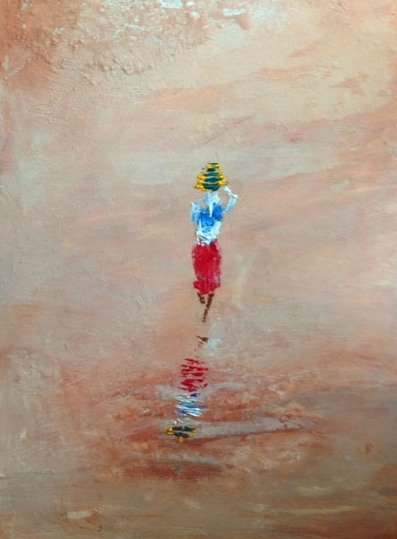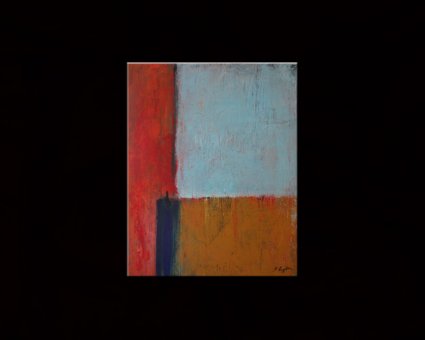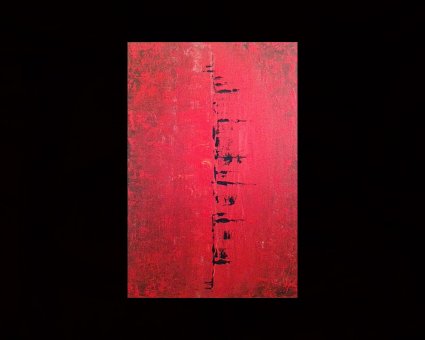 Girls Run This Motha!#% at Wyn317 Gallery
Girls Run This Motha!#% at Wyn317 Gallery
 Michelle Vasquez on Girl Power, International Women's Day and Representing for Miami
Michelle Vasquez on Girl Power, International Women's Day and Representing for Miami
Please share some of the steps of your journey as an artist.
As people and as artists, we are always growing and changing in hopefully more positive and mature directions. My journey as an artist has involved a great deal of growth and change in perspective since my early attempts at art, some of which still hang in the halls of my old high school. My goal is to always produce better art, but also art that reflects who I am now, in this moment. One of the things I’ve learned along the way is that you have to be inspired in order to paint—creating art is not like a work task with a beginning and end and timetable. If I am not truly inspired, the result will not be what I want even if I spend days and weeks applying paint to canvas.
Are your landscapes and cityscapes predominantly imaginative or inspired by actual places you have visited?
My art is equal parts imagination and inspiration. Having lived on three continents, my art is, without a doubt, influenced by the amazing places I have lived and visited, including Morocco, Russia and the U.S. I grew up near Marrakesh, and have vivid memories of narrow, colorful streets, the Kasbah, old-world people, the bazar and villages rising out of the mountains.
What are some of the subjects you explore in your abstract works?
My work depicts a variety of scenes from everyday life. For example, I created a series of paintings that address the social and economic issues faced by African women who are responsible for securing food for their families. In Morocco, domestic chores are strenuous in rural areas. Because their homes are not equipped with running water, women who live in rural areas of the country need to fetch water from places located an average of six miles away. This is the kind of manual labor that some Moroccan women, and African women in general, embrace as part of their daily lives. Although the labor may be specific to their households, it defines their roles in the community and gives them a sense of empowerment. My paintings portray women who are free, independent and strong.
How do the aesthetics and culture of your native Morocco inform your work?
I grew up in Youssoufia, a small rural town west of Marrakesh where people are very traditional and hard working. Everything is made from scratch—food, rugs, furniture, etc. My mom used to make rugs by hand. I think it’s part of the reason I use so many tools and media in my work in addition to brushes—it makes me feel like I’m creating something hand-made, unique; something that cannot be easily duplicated.
How was the experience of living and studying in Moscow?
Living in Moscow was tough in the beginning. I did not speak Russian when I moved there, but picked it up quickly because I was intrigued and wanted to start communicating with people; I was eager to experience Russian life. I really enjoyed Russian culture. It was an unforgettable experience, coming from a completely different culture and immersing myself in a new one. I was fortunate to have made a few close friends who were Russian natives who helped me understand their culture and traditions.
Where would you love to travel for inspiration and why?
Italy is on my “must see” list. It is one of the art capitals of the world. Where else can one see an entire floating city? I’m sure that everything I’ve read and heard about Italy can’t compare to the actual experience of being there. It will influence my art in unpredictable ways.
You paint with acrylic on canvas. Why did you choose acrylic?
I’ve experimented with a variety of mediums that include oil, water color and acrylic but acrylic has turned out to be my absolute favorite; it dries fast, it has this wonderful texture and unlike oil, it does not have the tendency to turn yellow as it ages and oxidizes. Honestly, I like to get messy when I work and acrylic paint makes cleaning up a lot easier too.
How do you choose the titles for your work?
Titles are tricky; they really come after the work is finished and are inspired by the work itself. Since my work is more abstract, the titles for my work tend to be abstract as well. I don’t want the titles of the work to be the focus; they shouldn’t influence the viewer to see the work in an overly specific way.
You currently have a piece in the Capitol Hill Art League. Could you tell us more about what the league does and also elaborate on your piece?
CHAL promotes the visual arts in the Washington, DC community of Capitol Hill and surrounding area. CHAL members are artists drawn from the neighborhood, the city and region. I was introduced to CHAL by one of my art teachers, Joyce McCarten, who is a fellow member and DC artist. The league is a wonderful, supportive community of incredibly talented people. My current piece on exhibit with CHAL is titled, “George” and is an interpretation of George Washington as one of DC’s most famous icons.
What ideas would you like to explore further going forward as an artist?
I like to constantly challenge myself to be a better artist and explore techniques and imagery that perhaps I am not comfortable with; there is so much to learn and so many ways to express myself on canvas. It is one of the reasons I don’t just shop at art supply stores; I shop at Home Depot too. I want to remain open to a variety of influences and mediums. The process of creating art is, in itself, as rewarding as the outcome. In the near future, I would like to explore more of the imagery of my native country.
What is the art scene like in Washington, DC?
Washington, DC boasts a vibrant, eclectic art scene that is as diverse as the people who live here, and is very contemporary. The great thing about art in DC is that it is so accessible; entry to most galleries is free.
Do you have any upcoming exhibitions?
I was selected to show my art in Results Gym, which was converted from an old primary school building in Capitol Hill. It is a terrific, unique space and I am excited to feature seven pieces from my art collection beginning March 8.



How would you describe your art?
I love to paint abstract pieces on canvas and wood in a way that creates a lot of texture. I experiment with mixed media to achieve rough, raised, textured surfaces because life is not smooth; it’s bumpy and interesting and colorful. I am intrigued by color and like to use unusual, vivid color combinations in my work. I want my art to tell a story but in a broad way that allows the viewer to individualize it and make it personal
 Heike Dempster
Heike Dempster